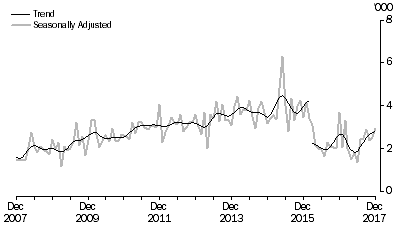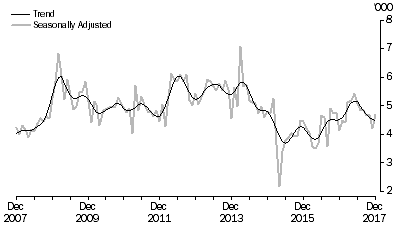TECHNICAL NOTE - SEASONALLY ADJUSTED AND TREND ESTIMATES
INTRODUCTION
Seasonally adjusted and trend estimates add to the understanding of overseas arrivals and departures (OAD) statistics. Seasonally adjusted estimates allow users to analyse short-term movements including irregular impacts on the series, while trend estimates provide a better method to analyse and monitor the underlying direction of the series. In most cases, the trend series is the best source of information on the long-term direction of these statistics.
The following graphs are provided to illustrate variations in the seasonally adjusted and trend series for selected countries. These graphs cover the period December 2007 to December 2017.
SHORT-TERM VISITOR ARRIVALS
Selected source countries
The graph for France shows in July 2008, the seasonally adjusted series increased significantly at the time World Youth Day was held in Sydney, which drew hundreds of thousands of participants from around the world. In April 2010, the seasonally adjusted series fell suddenly at the time of the volcanic eruptions in Iceland, which closed major airports in Europe for one week.
Sometimes there are abrupt and sustained changes in the underlying behaviour of short-term movement series, termed ‘trend breaks’. Given that these occasions can distort trend estimates, the ABS takes such breaks into account when smoothing seasonally adjusted series.
Analysis of short-term visitor arrivals from Pakistan shows the introduction of a break to the series in April 2016. This was necessitated by the sustained increase of visitor arrivals from Pakistan due to an increase in terrorist related activity and natural disasters during this period, including the Lahore suicide bombing and a mass flooding which left thousands displaced. There was also a large extreme identified in October 2008, which indicates a decrease in the number of visitor arrivals and was likely a result of the Islamabad Marriott Hotel bombing, as well as a major earthquake which again, displaced thousands of people.
A major increase in the number of short-term visitor arrivals from Spain is shown for July 2008. This can be attributed to World Youth Day events in Sydney. There was also a large extreme identified in April 2013, which indicates a decrease in the number of visitor arrivals and was likely a result of the high unemployment rates reflecting a depressed economy.
FRANCE, Short-term Visitor Arrivals
 PAKISTAN,
PAKISTAN, Short-term Visitor Arrivals
 SPAIN,
SPAIN, Short-term Visitor Arrivals

The first graph shows a sudden increase in short-term resident returns from Brazil in July 2014, coinciding with the FIFA World Cup. An increase was also identified in August 2016 which can be attributed to the Olympics held in Rio de Janeiro.
The graph of short-term resident returns from Turkey shows the introduction of a break to the series in March 2016, a result of the sustained decrease in travel there due to the suicide bombing attack in Ankara, Turkey on 13 March 2016.
A major decrease in the number of short-term resident returns to Vanuatu is shown for April 2015. This was caused by a series of disruptions of air travel to and from the island due to severe tropical cyclones, most notably Cyclone Pam in March 2015.
BRAZIL, Short-term Resident Returns
 TURKEY,
TURKEY, Short-term Resident Returns

VANUATU, Short-term Resident Returns

 Print Page
Print Page
 Print All
Print All
 Quality Declaration
Quality Declaration